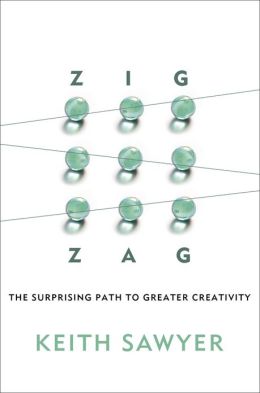The world’s most creative people develop better ideas by looking at situations from different perspectives than the rest of us. In particular, most people tend to start from where they are now when searching for creative solutions. A more productive approach, according to Keith Sawyer, author of Zig Zag: The Surprising Path to Greater Creativity, is to “go back from the future.”
In other words, picture your future goal – the problem solved – and then work backward to your current situation. Often, you know what you want to accomplish, what the ideal future state should look like. Where the creativity comes in is figuring out the intermediate steps that will take you there. Mind mapping is a great tool for this kind of “sleight of head” thinking, according to Sawyer:
“Instead of starting with your problem at the center of the (mind map), start with your desired end state. What will your life be like after you’ve found a creative solution?”
 Sawyer says this technique, which he has dubbed “BFF,” has been used to solve numerous thorny technical problems, like this one:
Sawyer says this technique, which he has dubbed “BFF,” has been used to solve numerous thorny technical problems, like this one:
“In the 1980s scientists working on the Jupiter space probe Galileo faced a major challenge— how to create a rocket booster large enough to propel the probe to Jupiter without damaging the delicate cargo bay at launch. The creative solution came via BFF: instead of focusing on the booster design, they focused on the goal: ‘We’ve arrived at Jupiter, and with lower rocket power. How did it happen?’
“At first, they were stumped. They’d already failed to figure out how to make it happen. And yet, by thinking back from the future, the engineers could speculate about a way it might have happened: perhaps they could have used the gravitational force of Venus to add force to the space probe long after its launch. If they timed the launch exactly right, a relatively small booster rocket would get the probe to Venus’s orbit, and the gravitational force of Venus would swing the probe around and give it the extra velocity needed to reach Jupiter.
“Launched in 1989, Galileo swung around Venus in 1990 and reached Jupiter on schedule in 1995, after traveling through space for five years. Galileo was an amazing feat of engineering, and BFF played a significant part in Galileo’s success.”
Here are some tips to use a radial mind map for this application:
- You don’t have to have just one “path” from the future back to the present. Use multiple branches to consider different scenarios.
- You can use other branches to contain supporting information, such as the assumptions you’re making about the future state or the solution, or supporting data – such as any constraints within which you must work. Use your imagination here. Add branches for any information that you believe is relevant to your situation.
- I’ve included a set of questions in my mind map, which serve as a helpful prompt to help me remember how to use it. Focused questions are powerful tools; they help us focus our efforts and can often reveal aspects of a problem or challenge that weren’t apparent before.
So how can you use a solution map to go “back from the future” to develop creative solutions to a challenge you’re facing?


Leave a Reply